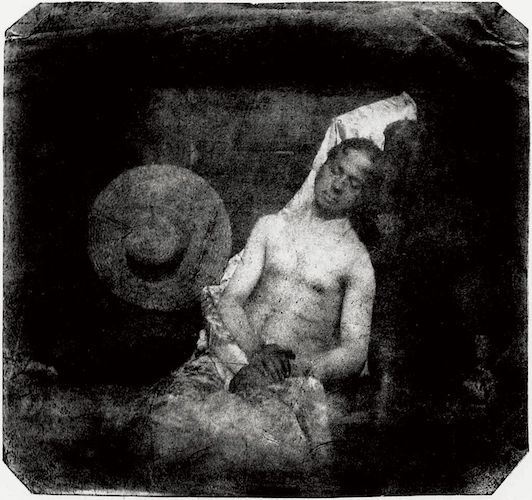This is the first staged photo.
这是人类首张摆拍照片。
It depicts a suicide.
描述的是一起自杀事件。
But it also tells a story.
这张照片背后还有一个故事:
Of an ambitious amateur inventor who found a way to achieve the incredible.
一位雄心勃勃的业余发明家发现了一种化不可能为可能的办法,
But was pushed aside by a powerful, meddling politician with his own agenda.
却被一个有权有势又爱管闲事的政客排挤了出去,
And doomed to obscurity.
注定变得默默无闻的故事。
Hippolyte Bayard was an artist. A gardener. A collector. And an experimenter.
希伯莱特·巴亚德是一位画家。也是一名园丁。一个收藏家。还是一位敢于实验的人。
And in 1839, he invented photography – sort of.
1839年,他发明了摄影——这么说也未尝不可。
People knew for centuries how to create an image with light,
好几百年前,人们就已经知道如何用光创造图像了,
but they didn’t have a way to permanently fix it onto a surface.
但是他们没有办法把它永久地固定在一个表面上。
Until several people actually figured it out all at once.
直到几个人同时想到了解决办法。
They invented their own methods,
他们发明了自己的方法,
building on years of individual experimentation and failed attempts.
而且各自都是在多年的个人实验和失败尝试的基础上研究出来的。
Bayard, in France, was one of them.
法国的巴亚德就是其中之一。
He was experimenting with photography in his free time while working a day job in a government office.
他白天在政府机关工作,业余时间就搞一些摄影方面的试验。
He found a way to fix images by dipping paper into photosensitive chemicals and exposing it to light inside a camera obscura,
他发现,把纸张浸入感光化学溶液,然后将其暴露在暗箱内的光线下能够固定住影像,
which is essentially a dark room with a tiny hole in it.
而这个暗箱差不多就是一个黑暗的房间,里面有一个透光的小洞。
You can actually see stains from excess chemicals in his earliest successful attempts.
我们甚至还能从他早期成功的那些尝试上看到过量的化学物质留下的痕迹。
His photographs prominently featured his home and garden,
他的照片主要拍的都是他的家和他的花园,
where he would arrange tools, statues, and vases into loaded still lifes.
在拍之前,他会把工具、雕像和花瓶摆放成精美的静物画的样子。

Also windmills. He loved windmills.
还有风车。他很喜欢风车。
Often he included himself in the scenes, eyes closed because of the long exposure time his process required.
他经常会把自己也拍进去,由于曝光需要的时间很长,所以照片里的他都是闭着眼睛的。
But he’s not the photo pioneer you might have heard of.
但大家听说过的摄影先驱可能并不是他。
That would be this guy: fellow Frenchman Louis Daguerre.
而是这个人:法国人路易斯·达盖尔。
Daguerre had already made a name for himself
十九世纪二十年代,达盖尔就已经颇有名气了,
and captured the public’s attention in the 1820s with popular interactive art shows, called “dioramas.”
他举办的流行互动艺术展览“立体模型”吸睛指数也很高。
Fixing an image to a surface was his next big ambition.
他接下来的雄心壮志就是将图像固定在一个表面上。
And by the late 1830s, he’d had his own breakthrough with photography,
十九世纪三十年代末,他在摄影上就已经有了自己的突破,
successfully creating a process to fix an image to a metal plate.
他成功地发明了将图像固定在金属盘上的办法。
He called his invention the Daguerreotype.
他称这一发明为“银版照相法”。
He kept his discovery mostly under wraps,
并且很大程度上将其作为秘密保守了起来,
showing the Daguerreotypes to just a few influential members of society,
只对社会上几个有影响力的人展示过,
who would then spread rumors of his success to the press.
这些人后来却把他成功的消息泄露给了媒体。
Bayard, on the other hand, worked alone, but he was eager to share his work.
另一边,巴亚德也在单枪匹马地奋斗着,但他也很渴望分享他的成果。
In June 1839 he held a photo exhibition,
1839年6月,他举办了一个摄影展,
becoming the first photographer to show his work in public.
成了第一个公开展示作品的摄影师。
One attendee later wrote, “they were like nothing I’d ever seen…
一位参观者后来写道:“我从未见过那种作品……
they unite the impression of reality with the fantasy of dreams.”
它们把对现实的印象和对奇幻的梦想结合起来了。”
Bayard was prepared to demonstrate his process to the Academy of Sciences, the highest scientific authority in France.
巴亚德准备向法国最高科学权威法国科学院展示他的成像方法。
And that’s where Francois Arago comes in.
就在这时,弗朗索瓦·阿拉戈出现了。











